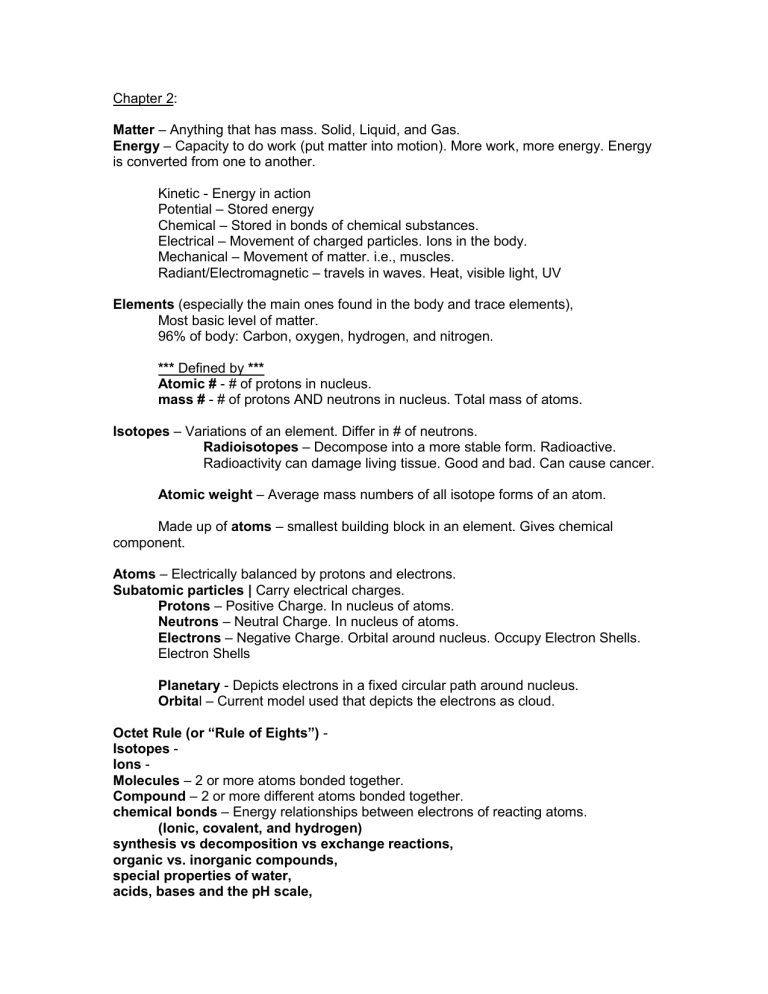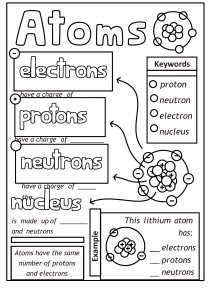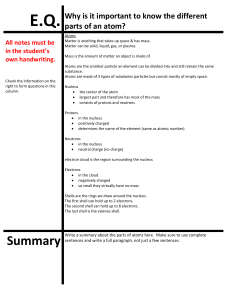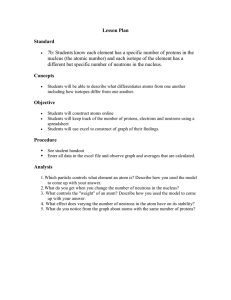
Chapter 2: Matter – Anything that has mass. Solid, Liquid, and Gas. Energy – Capacity to do work (put matter into motion). More work, more energy. Energy is converted from one to another. Kinetic - Energy in action Potential – Stored energy Chemical – Stored in bonds of chemical substances. Electrical – Movement of charged particles. Ions in the body. Mechanical – Movement of matter. i.e., muscles. Radiant/Electromagnetic – travels in waves. Heat, visible light, UV Elements (especially the main ones found in the body and trace elements), Most basic level of matter. 96% of body: Carbon, oxygen, hydrogen, and nitrogen. *** Defined by *** Atomic # - # of protons in nucleus. mass # - # of protons AND neutrons in nucleus. Total mass of atoms. Isotopes – Variations of an element. Differ in # of neutrons. Radioisotopes – Decompose into a more stable form. Radioactive. Radioactivity can damage living tissue. Good and bad. Can cause cancer. Atomic weight – Average mass numbers of all isotope forms of an atom. Made up of atoms – smallest building block in an element. Gives chemical component. Atoms – Electrically balanced by protons and electrons. Subatomic particles | Carry electrical charges. Protons – Positive Charge. In nucleus of atoms. Neutrons – Neutral Charge. In nucleus of atoms. Electrons – Negative Charge. Orbital around nucleus. Occupy Electron Shells. Electron Shells Planetary - Depicts electrons in a fixed circular path around nucleus. Orbital – Current model used that depicts the electrons as cloud. Octet Rule (or “Rule of Eights”) Isotopes Ions Molecules – 2 or more atoms bonded together. Compound – 2 or more different atoms bonded together. chemical bonds – Energy relationships between electrons of reacting atoms. (Ionic, covalent, and hydrogen) synthesis vs decomposition vs exchange reactions, organic vs. inorganic compounds, special properties of water, acids, bases and the pH scale, buffers carbohydrates, lipids, proteins and nucleic acids, DNA, ATP. Chapter 3: Cell Theory, cell (or plasma) membrane (including its functions and various parts), glycocalyx, cytosol, organelles (including cytoskeleton, centrosome, cilia, flagella, ribosome, endoplasmic reticulum [both rough and smooth], Golgi complex, mitochondria, lysosome, nucleus), tight junction, desmosome, gap junction, passive transport (including diffusion, osmosis, isotonic, hypertonic, and hypotonic solutions) vs. active transport (including endocytosis and exocytosis), the cell cycle and mitosis, DNA replication, and protein synthesis (including transcription and translation), the 3 types of RNA (mRNA, tRNA, and rRNA) and their functions.







